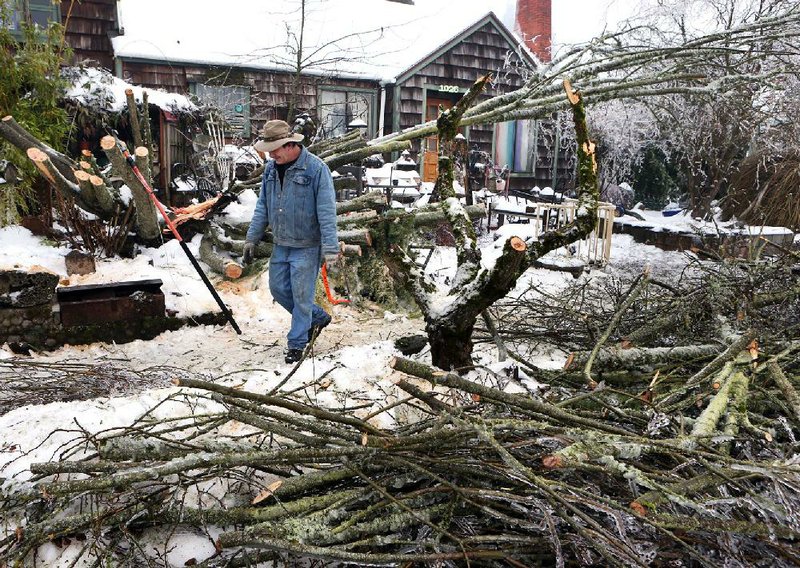SEATTLE - A weekend storm disrupted plans across the Northwest U.S., blanketing parts of Washington state with snow, socking Oregon and California with rain and contributing to the deaths of three people.
Seattle-area residents woke up to rare lowland snow Sunday. Meanwhile, Portland, Ore., city officials sent out a cellphone alert Sunday morning urging residents to stay indoors and avoid travel after freezing rain turned streets and sidewalks into thick sheets of ice.
The National Weather Service said the first significant storm to hit Northern California in 14 months produced impressive amounts of rain and snow, but forecasters cautioned Sunday that it would take weeks of similar drenching to end the state’s immediate drought worries.
“This event, while it certainly isn’t going to take us out of the drought, we couldn’t have asked for a better storm,” meteorologist Scott McGuire said in Reno, Nev. “We are seeing very, very impressive rainfall and snowfall amounts.”
In central Oregon, the Deschutes County sheriff’s office was investigating three storm-related deaths, including that of a 61-year-old Bend man who collapsed while shoveling snow outside his home. An elderly couple also were found Saturday buried in snow, and authorities think they were walking through heavy snow on an unplowed driveway to their home.
Officials in the Portland and southwest Washington areas warned of an icy morning commute today as the National Weather Service on Sunday afternoon issued a freezing-rain advisory for the region from 4 a.m. to noon.
In Portland, about 40 flights, or less than 10 percent of the typical 500 daily flights, were canceled Sunday morning. Most flights were getting in and out of the airport though with some delays, Port of Portland spokesman Steve Johnson said.
Freezing rain Saturday made conditions treacherous in the metropolitan area, forcing transportation officials to temporarily suspend light-rail and streetcar services before resuming them Sunday morning.
By Sunday, nearly 3 inches of snow had fallen at Seattle-Tacoma International Airport, the heaviest snowfall in a single day at that location in about two years. Parts of southwest Washington got hammered, with as much as 5 inches or more in south Thurston County and some parts of Lewis County.
Josh Smith, a meteorologist with the National Weather Service in Seattle, said temperatures were expected to rise above freezing by late Sunday.
High avalanche danger prompted officials at Mount Rainier National Park to close the gate to Paradise at Longmire on Sunday.
Parts of the northern San Francisco Bay Area saw sizable amounts of rain along with flash-flood warnings. By Sunday, Woodacre, which has the highest base elevation in Marin County, had received more than 10 inches of rain since the storm moved in Friday, while downtown San Francisco got more than 2 inches, said Austin Cross, a National Weather Service meteorologist in Monterey, Calif.
The storm, powered by a warm, moisture-packed system from the Pacific Ocean known as a Pineapple Express, was expected to produce more rain Sunday before moving east.
Forecasters on Sunday warned of avalanche conditions across much of Colorado’s high country as snow continued to fall in the region. The Colorado Avalanche Information Center issued the warning for most of the central and northern mountains through midday today.
Across the country, about 38,000 utility customers in Pennsylvania remained in the dark four days after an ice storm knocked down trees and snapped power lines.
The number of customers without power has dropped from a peak of about 850,000 after Wednesday’s storm. Most of the power failures are in the Philadelphia area.
Maryland also was hit hard by the ice storm. Emergency-management officials reported hundreds of customers remained without power there Sunday.
A tour bus going too fast on a snow-covered road crashed in southwestern Pennsylvania on Sunday, sending 26 of the 33 passengers to the hospital with minor injuries, officials said. All but three were treated and released, hospital officials said.
Georgia Emergency Management Agency’s Ken Davis told the Atlanta Journal-Constitution that the agency had a mass alert system in place called the Integrated Public Alert and Warning System, but the technology hadn’t been configured, tested or used for weather and traffic alerts before the Jan. 28 storm.
The Integrated Public Alert and Warning System is a public-private partnership between cellphone carriers and federal agencies. The state in 2012 was given federal approval to use the system, which would have sent a 90-character message, similar to an AMBER Alert, to cellphones within a geographic area.
Information for this article was contributed by Lisa Leff and staff members of The Associated Press.
Front Section, Pages 2 on 02/10/2014
